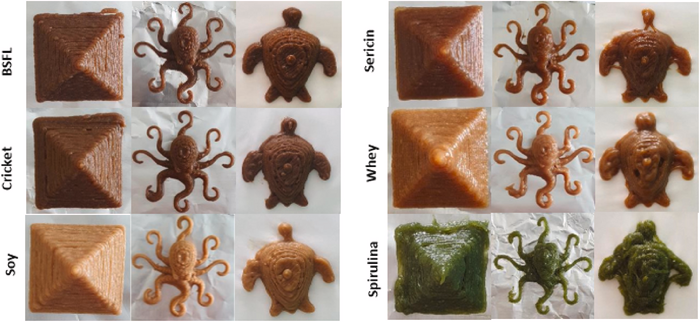The demand for food that is high in protein is anticipated to rise along with the aging and expanding global population. Concerns over rising greenhouse gas emissions and increased water and land use due to conventional methods of raising animals for food have also been raised.
 Optimized ink printing of pyramid, octopus and turtle from left to right of different protein inks. Image Credit: Singapore University of Technology and Design.
Optimized ink printing of pyramid, octopus and turtle from left to right of different protein inks. Image Credit: Singapore University of Technology and Design.
People have already started using alternate sources of proteins from plants, algae, and insects in several regions of Africa, Asia, and South America to produce nutrient-dense, sustainable food. For the rest of the world, however, it might be difficult to comprehend the idea of eating insects.
The appearance and taste of such alternative proteins can be disconcerting for many. This is where the versatility of 3D food printing rises to the challenge as it can transform how food is presented and overcome the inertia of consumer inhibitions.
Chua Chee Kai, Study Co-Author and Professor, Singapore University of Technology and Design
For instance, to provide a more recognizable flavor for customers, typical foods like carrots can be combined with alternative proteins like crickets. A 3D food printer can then extrude this blend of carrots and bugs to produce a dish that is both aesthetically pleasing and delicious.
Combining various food inks and optimizing them for 3D food printing is known to be a difficult operation, as it is often carried out using a trial-and-error methodology.
To effectively incorporate alternative proteins into food inks, Professor Chua and his colleagues from SUTD worked with scientists from Khoo Teck Puat Hospital (KTPH) and the University of Electronic Science and Technology of China (UESTC). By limiting the number of experimental runs, the study team minimized time and resources while optimizing protein inks.
In their study, “Systematic Engineering approach for optimization of multi-component alternative protein-fortified 3D printing food Ink” which was published in Food Hydrocolloids, the group employed Response Surface Methodology, a well-known engineering technique, for the printing of 3D foods.
Alternative proteins may become our main source of protein intake in the future. This study proposes a systematic engineering approach to optimizing food inks, thereby enabling easy creations and customizations of visually pleasing, flavorful, and nutritionally adequate food enhanced with alternative proteins. We hope our work would encourage consumers to eat more of these unfamiliar, but sustainable food items.
Yi Zhang, Study Principal Investigator and Professor, University of Electronic Science and Technology of China
The study team optimized the protein ink compositions with three variables—carrot powder, proteins, and xanthan gum—using the central composite design approach. In addition to flavor, nutrients, and color, the carrot powder helped provide mechanical strength to the formulated inks.
They also experimented with different proteins like sericin, soy, spirulina, crickets, and black soldier fly larvae. Experimentally developed inks were tested for 3D printability and syneresis, with optimized inks obtaining the highest printability and the lowest syneresis.
Aakanksha Pant, corresponding author of the paper and Research Associate from SUTD stated, “This research study can also be generalized for other food ingredients and the response of the food inks like texture, printability, water seepage may be included for optimization. The response surface method approach may lead researchers to adopt a similar method for optimizing 3DFP food inks constituting complex multicomponent food ingredients.”
Journal Reference:
Zhang, Y., et al. (2022) Systematic Engineering approach for optimization of multi-component alternative protein-fortified 3D printing food Ink. Food Hydrocolloids. doi.org/10.1016/j.foodhyd.2022.107803.